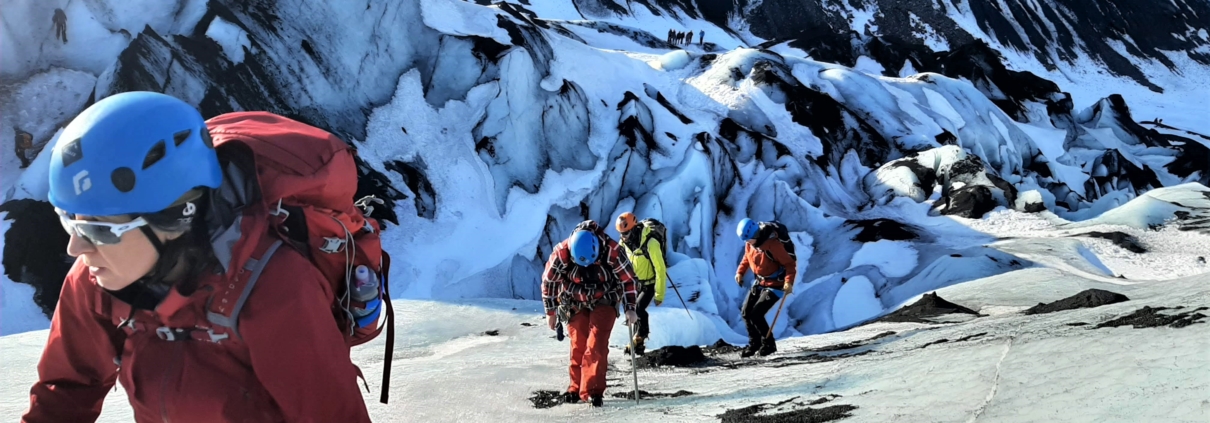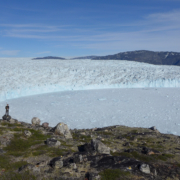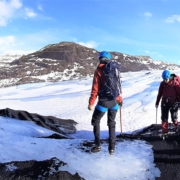Field preparations: Training for worst-case glacier scenarios in Iceland
Glaciologists from GEUS practice glacier safety on a regular basis in order to maintain nessecary safety skilld needed for field work on the Greenland Ice Sheet. In March 2022 they went to Iceland to practice safety and crevasse rescue and here you can tag along.
“How the hell do you prepare for that?!” exclaims a shocked course participant on the snow-covered Icelandic slope as her backward tumble down the hill with snow, arms and legs in all directions, is finally brought to a halt.
The fall was deliberately induced about 30 seconds earlier by her rope buddy in a simulation of being a two-person exploration team connected by a rope, one of whom falls into a glacier crevasse and pulls the colleague at the other end of the rope with them.
That is precisely the task of the day: trying to prepare for that situation; having felt the surprisingly surprising fall situation on one’s own body under controlled and safe circumstances. That way you do not get just as surprised if it should happen while working on the Greenland Ice Sheet, where help can be hundreds of kilometres away.
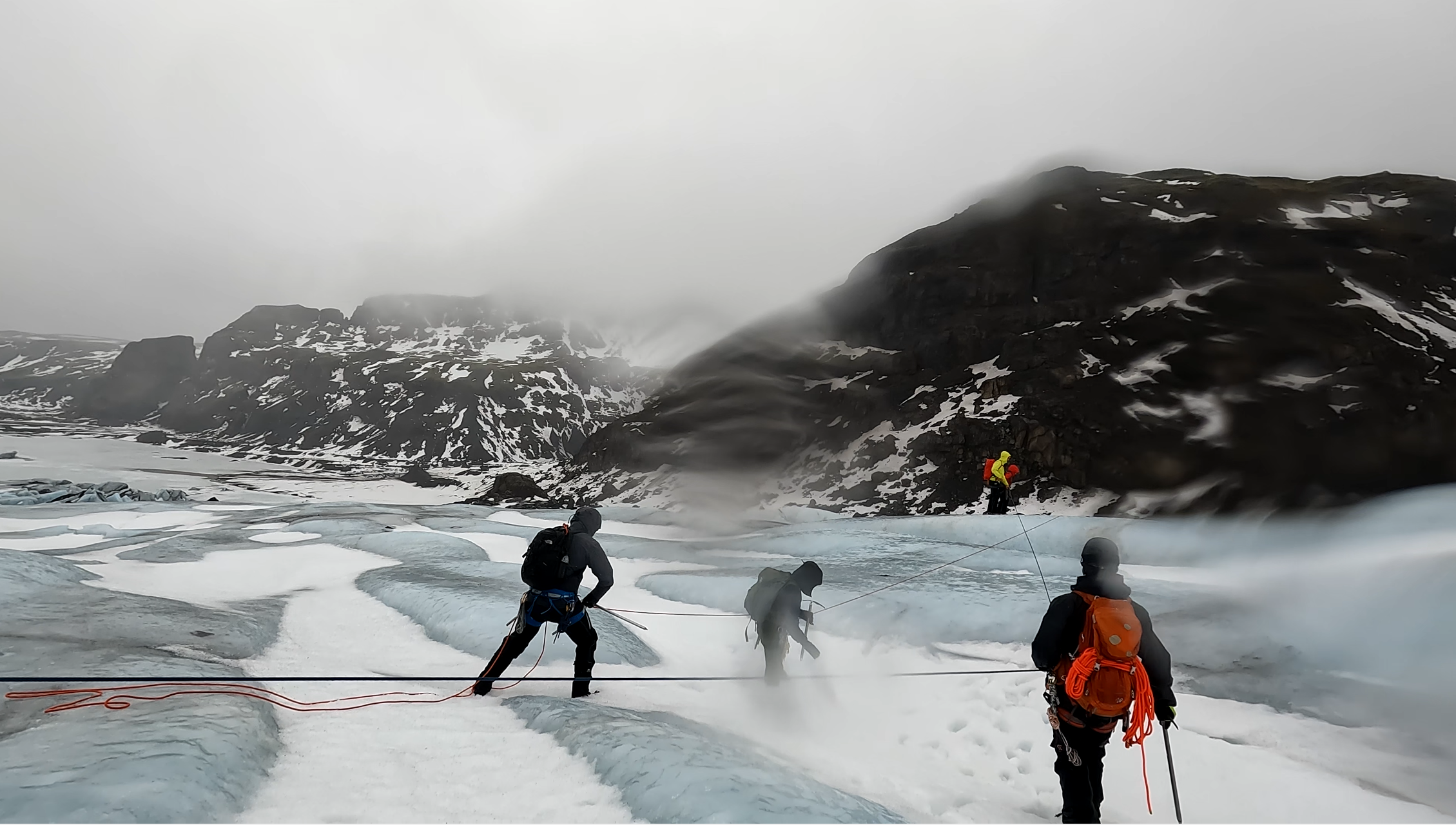
On the training glacier, practicing rescue in very ‘authentic’ weather conditions (Photo: Johanne Uhrenholt Kusnitzoff, GEUS)
On the ridge are nine glaciologists, technicians and assistants from the National Geological Survey of Denmark and Greenland (GEUS) plus three partners from the Dutch Utrecht University. All are busy in various stages of the glacier safety exercise with the goal of stopping one’s own fall down the slope and then hauling your fallen colleague back up. That is, if you even get that far and don’t both fall over the ‘glacier edge’, which today is played by a snow-covered slope in southern Iceland, because the weather on the intended training glacier was too poor.
“Arghh, hang still!” someone else shouts somewhere on the slope, where another two-person team had a more successful self-arrest in the snow, but now rope buddy no. 1 is in big trouble withstanding the pull of his fallen colleague, whose full weight hangs in the harness straps around his hips. And at the same time the fallen colleague is wiggling around down his end of the rope to simulate being in panic.
A minute margin of error
“It’s going to hurt,” our Icelandic glacier guide Jón Andrésson informed us ten minutes before, as he and his colleague Mike Reid played out the scenario for us. And he wasn’t lying. The straps cut into the hip despite the five to six layers of winter clothing. Even though we knew exactly what was going to happen, the body is in shock after suddenly being pulled off balance on the slope and having nothing but snow to grab hold of.
Why does the ice have crevasses?
Ice in a glacier is moving. When the ice moves over rough terrain, or the flow velocity of the ice changes, it strains the ice forcing it to crack. These cracks are called crevasses. Glacier ice will typically flow faster the closer you get to the front of the glacier, which is why this part of an ice cap has the most crevasses.
When you somehow manage to hack your boots into the snow with enough force to stop yourself, it takes all your strength to hold yourself somewhat upright fighting against the pull from below. All your movements have a maximum margin of error of a few millimetres in the most fragile of equilibriums, where the point of balance constantly shifts due to movements and jerks on the rope induced by your distressed colleague at the other end.
And you can’t just lie there. Now your task is, as quickly as possible, pull out your ice axe and dig a trench approximately half a metre deep in the snow in front of you and use the axe to build a so-called snow anchor to which you transfer your colleagues’ weight. If you are not so unlucky to have dropped the axe in your uncontrolled backward tumble down the hill moments before, that is.
With 70-80 kilos constantly pulling on you, you have to find the right rope in your belt, unclick it, tie it around the axe with the correct knot, force the axe down into the bottom of the snow trench, turn around, and tie the anchor rope to the main rope.
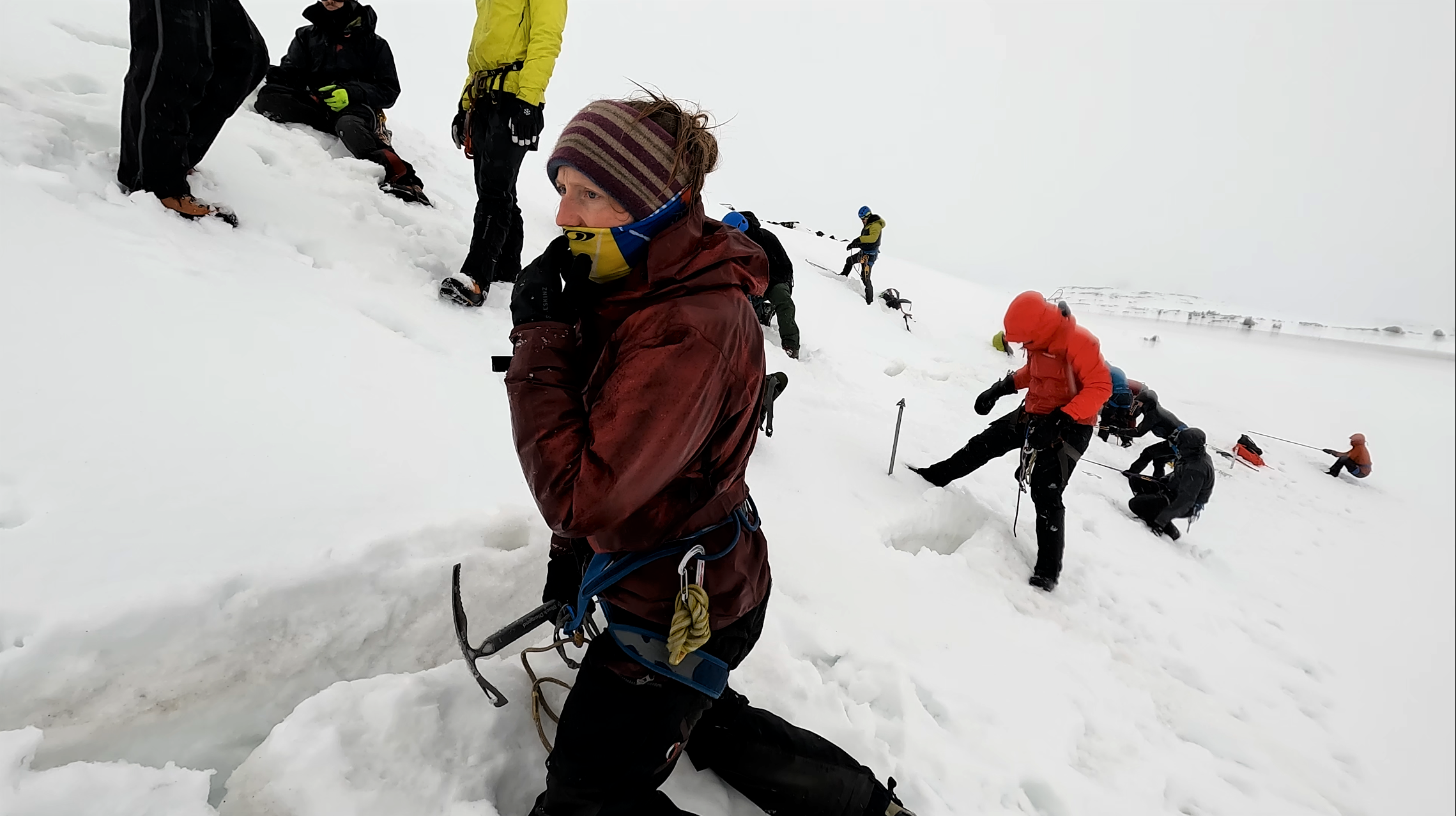
The team is practicing to build snow anchors prior to the actual rescue test (Photo: Johanne Uhrenholt Kusnitzoff, GEUS)
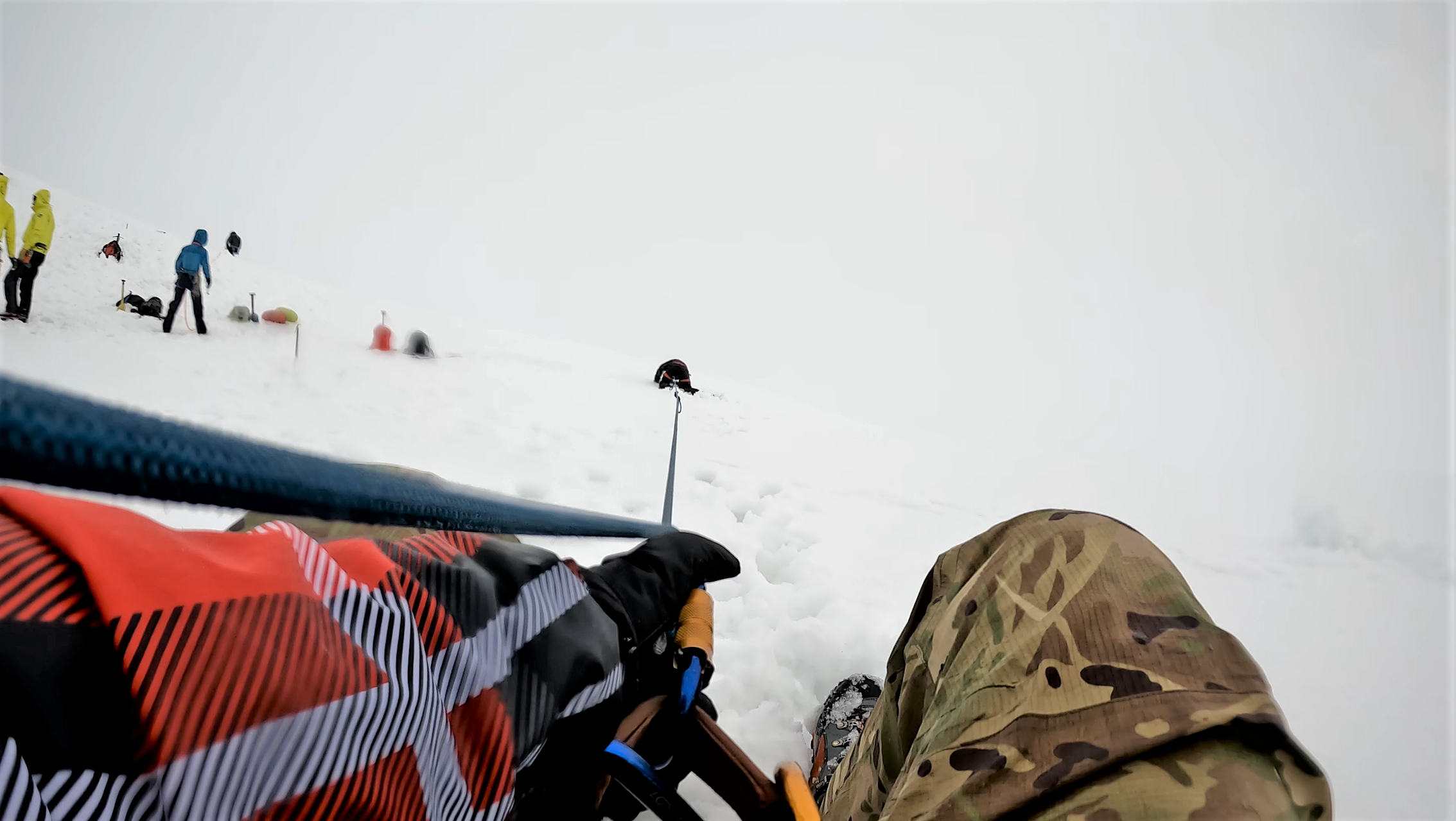
Building a snow anchor while holding the weight of a colleague simulating to have fallen into a crevasse while tied up in rope teams. (Photo: Johanne Uhrenholt Kusnitzoff, GEUS)
Now you can – carefully – move back a little and gradually let the anchor rope take over the weight, while constantly keeping an eye on any signs of ‘anchor failure’. That is, the snow axe starting to be torn through the front of the snow trench because the snow is not strong enough after all. If that happens, and you don’t have time to save your system before it fails, you must be ready for a new fall down the hill and to do it all over again. If the glaciers edge doesn’t get there first.
The Icelandic training glacier
All of this is, of course, an exercise.
No one was in danger, and everything took place under the supervision of two experienced glacier guides. As mentioned, on that particular day the glacier crevasse was not a crevasse, but a snow-covered hill. Which was uncomfortable enough as it was.
However, the glacier crevasses are a very real risk that must be addressed when the GEUS glaciologists from the Department of Glaciology and Climate, as well as accompanying technicians and assistants, go to the Greenland Ice Sheet each year when they work to uncover, understand and monitor the melting of the ice.
Sometimes the crevasses are not that deep, other times they are several hundred metres deep, full of cascading meltwater and sharp edges. Sometimes they are visible and sometimes they are hidden under freshly fallen snow. The Greenland Ice Sheet is a glacier, albeit a giant one, and therefore it requires knowledge of glacier safety to move around on it. This includes being able to identify where the crevasses are, choosing the safest route, moving around safely on the ice, and being able to rescue oneself and others from a crevasse if – against all expectations – an accident should indeed happen. Fortunately, that is extremely rare.
Safety courses for working on the ice sheet
Employees from GEUS going on field work on the Greenland Ice Sheet always undergo safety training before departure. Some courses are mandatory, but there is always a close connection between the nature and geography of the fieldwork and the courses required. When working on the ice, an updated glacier safety course is requirered, and if the fieldwork requires bringing firearms for self-defense against polar bears, rifle or revolver training is mandatory as well. The courses need to be refreshed at regular intervals, most within three years and some every year.
Still, it doesn’t suffice just reading about it. Therefore, GEUS requires that anyone going to areas of the Greenland Ice Sheet with risk of crevasses must undergo a series of safety courses. The glacier safety course, which takes place over three days on the Icelandic glacier Sólheimajokull, is one of those courses. It is both easier and cheaper to get to Iceland than to Greenland, and a crevasse is a crevasse wherever it is. Sólheimajokull is a couple of hours drive from Reykjavik and is also very easy to access. From a large, gravelly parking lot, you look straight over at the glacier’s serrated, grey-blue mass twisting between two mountain ridges.
In the shelter of the glacier
As we arrive at the glacier before noon on the first day, the enthusiasm has been a bit challenged by rain, sleet and wind pounding ominously against the car windows on the way. However, Jón Andrésson from the guide company Asgard Beyond, who is responsible for the course, is not downhearted.
“It looks a little brighter on the horizon where we are going. And I think that the glacier itself and the mountains behind it will shield us from the wind,” he said in the car. And sure enough: as we jump out of the cars, the wind has subsided, and the rain has almost stopped.
The trunk of the minibus is opened and large buckets full of climbing equipment, crampons and ice axes are hauled out onto the icy ground. A sense of calm concentration descends as everyone pulls on the last layers of wind and waterproof clothing and begins to ‘gear up’. Climbing harnesses are tightened, different types of carabiners, lanyards and pulleys are clipped in the belt together with ropes in different thicknesses and lengths as well as a set of long screws. Helmet on, ice axe in hand.
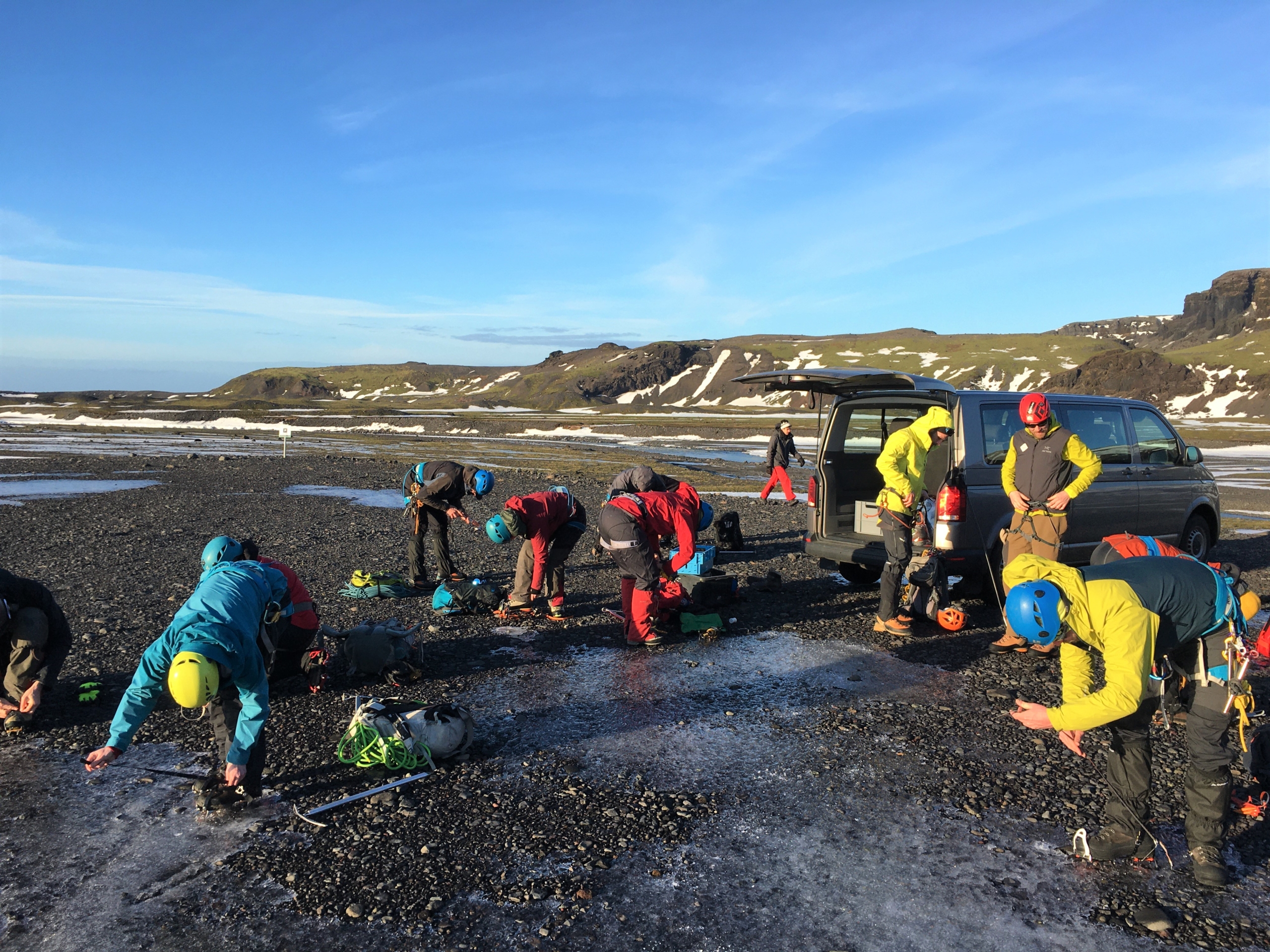
Gearing up in the parking lot (Photo: Johanne Uhrenholt Kusnitzoff, GEUS)
Many have brought their own equipment so they can test the things they will be using on the ice sheet this summer. However, most of us need to borrow crampons, which are soles full of sharp metal spikes that you fasten on your boots, so you don’t slip on the bare ice surfaces.
The pile of crampons looks a bit like props from a death metal music video. Several of the participants are a little unsure about how to put them on, so guide number two, Mike Reid, helps. First, they are adjusted in size, and then they are tied around and around the boot with long black nylon ties like some kind of aggressive ballet shoe.
“OK, is everyone protected against the cold?” Jón asks after ten minutes. “Is everyone geared up?” Off we go.
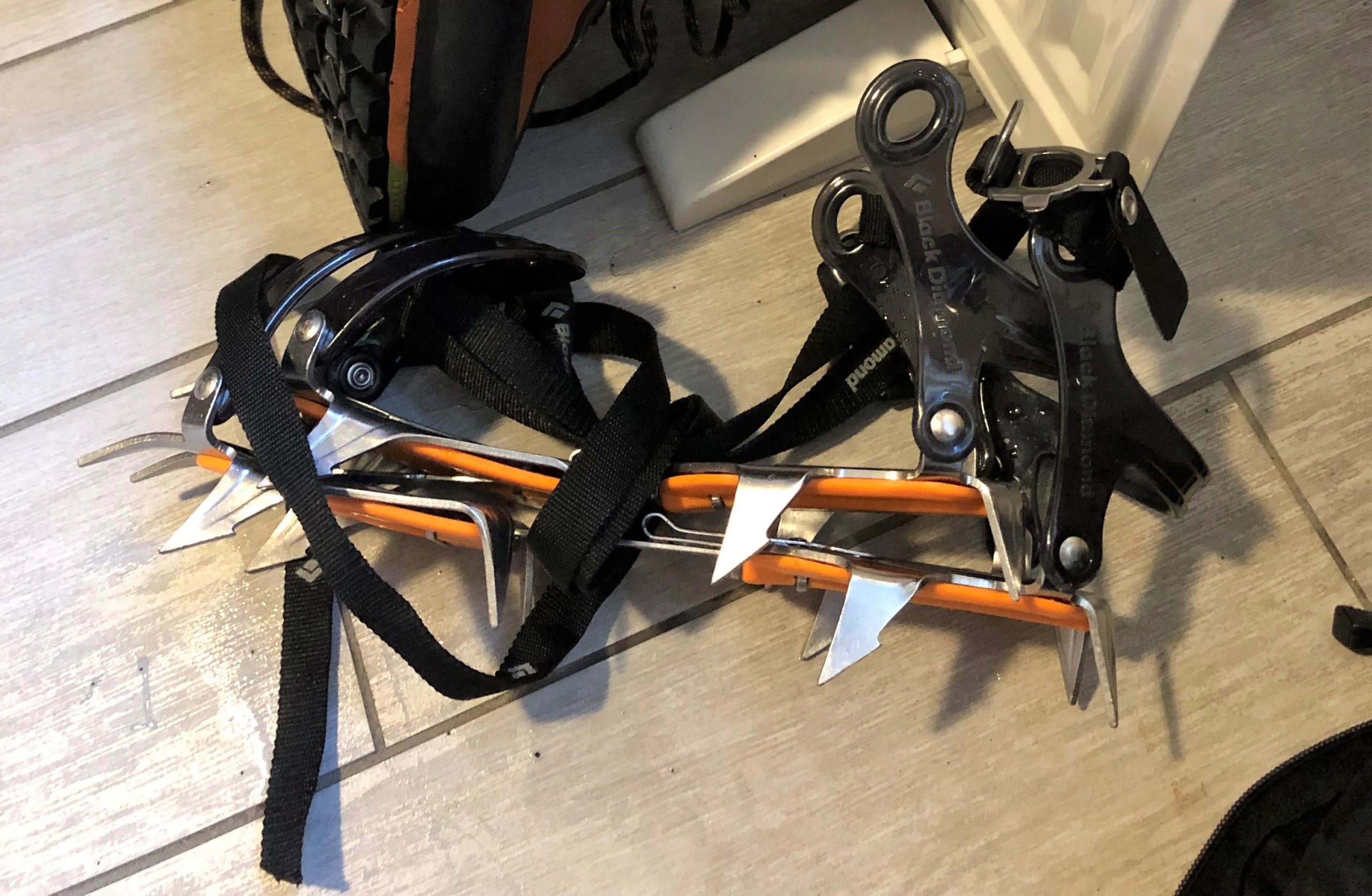
Crampons (Photo: Johanne Uhrenholt Kusnitzoff, GEUS)
Traversing in the frozen sea
Slightly more than half of the participants have been attending the course at Sólheimajokull before, or they have been on similar courses on Svalbard, in Switzerland or in Canada. One of the new faces on the glacier is GEUS researcher Signe Hillerup Larsen, who had her glacier course postponed a few years in a row due to the corona epidemic. However, she has been on the Greenland Ice Sheet before and has taken courses in the different climbing and rescue techniques in the forest area Hareskoven north-west of Copenhagen. That is the part of safety training called ‘dry training’ (tørtræning) by the glaciologists: the same exercises as the glacier course, just without the glacier. They do it approximately once a year to keep their rescue skills from the ‘real’ course fresh in mind. Heading towards a wall of ice is therefore not unfamiliar to her.
“I am looking forward to doing the exercises on actual ice, and I have not worn crampons before so that’s good to practice. We do not usually use them in the places where I go; hiking boots are usually enough,” she says.
The parts of the ice she usually works on is usually covered with snow or it is bumpy and rough on the surface due to melting, she explains.
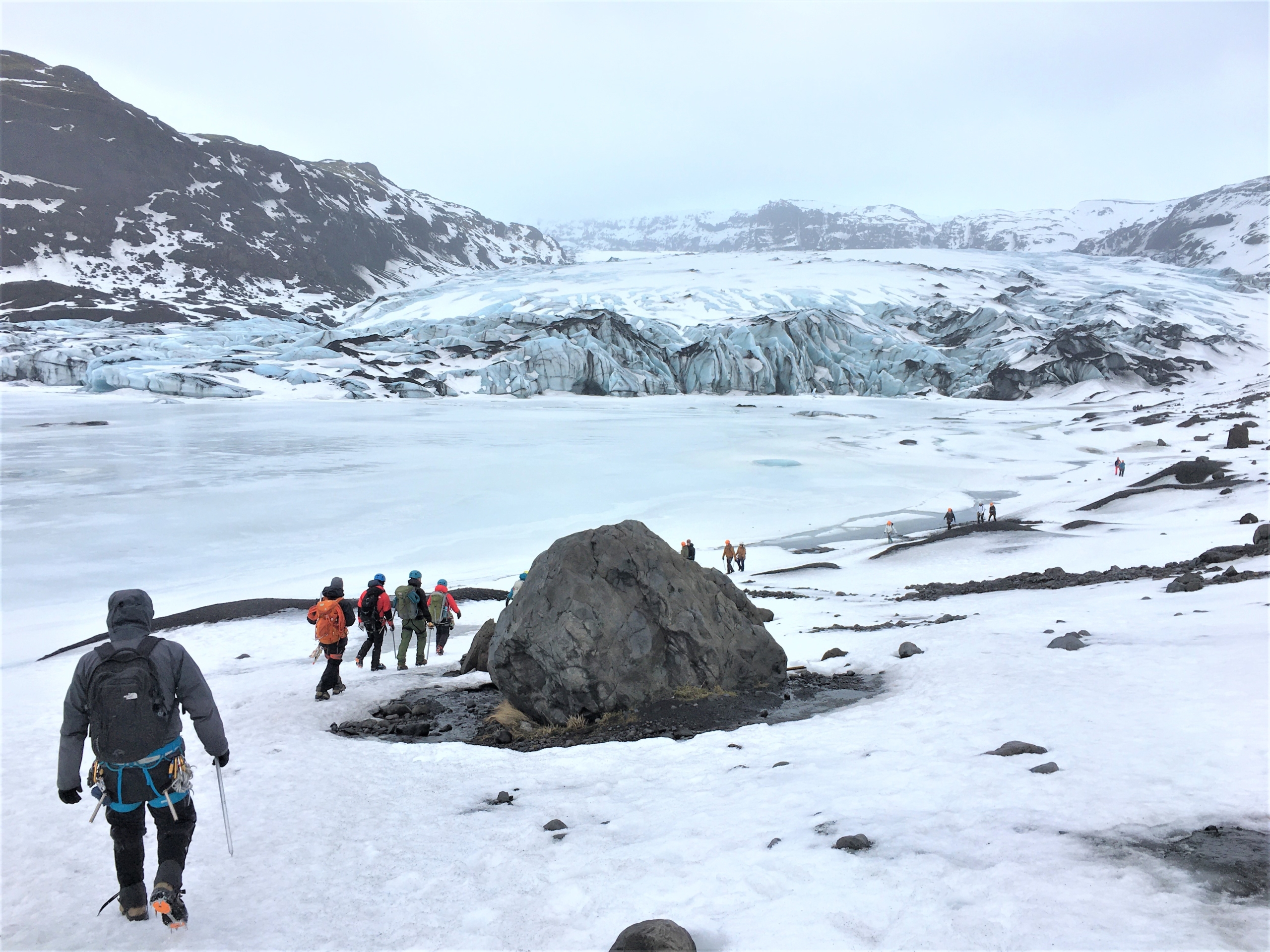
Walking towards the glacier on day one (Photo: Johanne Uhrenholt Kusnitzoff, GEUS)
It is about a ten-minute walk to the glacier along the ice covered river of melt water running form the glacier front out to sea. The high frequency ‘shree, shree’ friction sound of the ski pants is mixed with rhythmic, metallic clinking from all the carabiners and ice screws dangling from the belts, and the crispy ‘crunch, crunch’ of 14 sets of crampon spikes cutting into wet snow and layers of ice. At the glacier itself, the caravan of colourfully insulated figures turns left between the blueish grey ice walls as tall as buildings. We walk between enormous frozen waves in an ice ocean, like the Israelites passing through the Red Sea.
“Let’s stop here for a moment and practice traversing,” Mike Reid says as we pass a slightly smaller wave of ice. Traversing, he explains, just means walking on a steep ice surface wearing crampons. Mike leads the way and shows us how to first point your feet 45 degrees out to each side and kick the spikes well into the ice when you walk upwards. When walking sideways, the foot facing the slope should be perpendicular to the one on the steep side, which is pointing straight forward. Still kicking in the spikes with every step. Walking downwards, you really have to kick in the spikes, lean all the way back and use the axe to support your weight on the wall behind you.
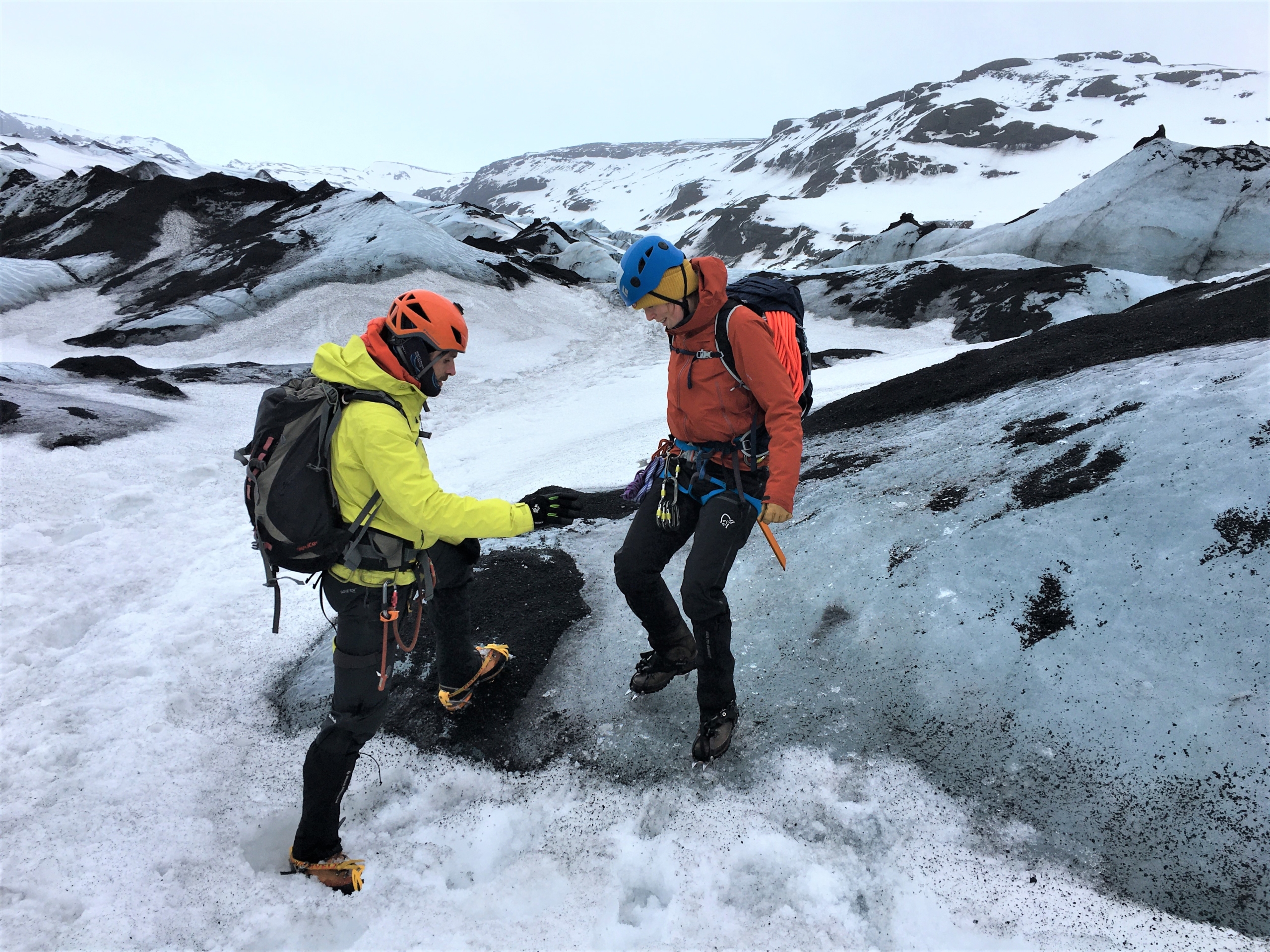
Signe Hillerup Larsen traversing down a small slope while guide Mike Reid assists (Photo: Johanne Uhrenholt Kusnitzoff, GEUS)
“You really have to exaggerate, you should look foolish when you are going down,” Mike says. Everyone has a go. You feel pretty cool wearing shoes that overcome the law of gravity, letting you walk up a bare ice slope. Signe Hillerup Larsen asks if we can have another go. We walk up, sideways and down again for a few minutes until everyone is confident that the spikes really do hold their weight on even the steepest parts of the ice surface.
Then it is time to do the same on an almost vertical surface. Here, the front spikes on either one or both boots are kicked into the ice with every step, so that our weight rests entirely on them. This is called ‘front pointing’. Mike is satisfied with the progress, and we traverse further on into the bluish-white maze.
Time for knots
Between two steep ice walls we stop. This is where the rescue exercises are to take place. There is a short break where we eat our lunches bought hastily in a supermarket on the way. The five-six metres tall ice walls shield us from the wind which has been picking up, and they provide an embracing feeling. The walls, however, are not our friends. The rest of the day they will act as a hostile crevasse as we have reached the next point on the agenda. The ability to rescue yourself or others or even things that have fallen over the edge and into the “crevasse”.
Here, the two long ice screws we’ve all been carrying in our belts come into play. They must be screwed into the ice approximately 30 cm apart and then connected with a strap hooked to a carabiner pointing towards the edge of the ice.
“How you like them apples?!” says Mike Reid gesturing at the demonstration ice anchor which, he adds, holds well over 1000 kilos. Our turn.
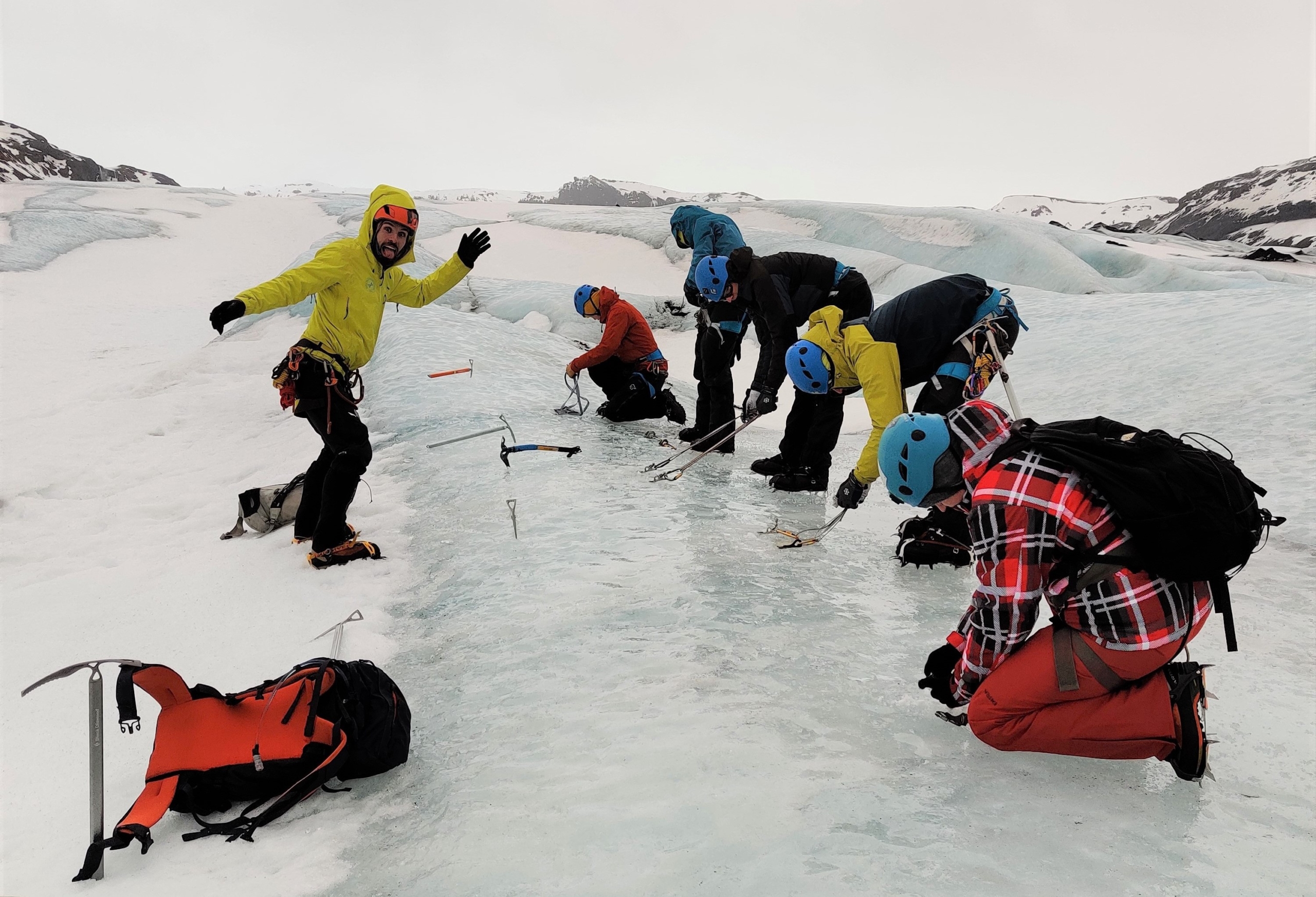
Part of the team making ice anchors under guidance of Mike Reid (Photo: Anne Munck Solgaard, GEUS)
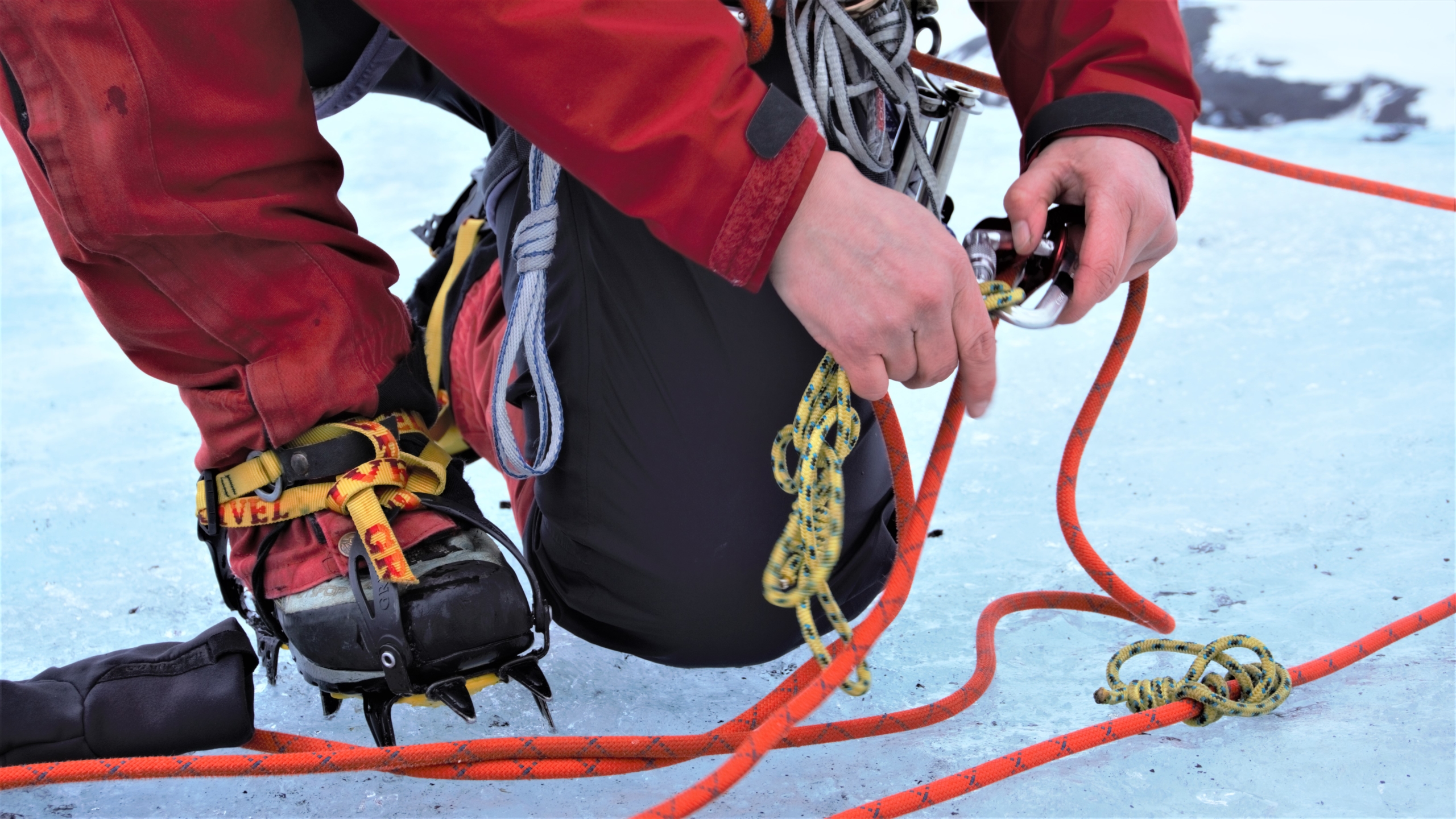
Tying knots (Photo: Johanne Uhrenholt Kusnitzoff, GEUS)
It’s surprisingly effortless working the screws into the ice. Soon after, ice anchors have been constructed all along the ice edge. Now the knot lessons begin. Within minutes, Mike Reid has tied at least four to five different kinds with different ropes and straps from the equipment belt. ‘Clove Hitch’, ‘Prusik’, ‘Figure eight’, ‘Double Fisherman’s Knot’, etc. They are all necessary if you are going to rappel down a rope hanging from the ice anchor. This part almost everyone has become acquainted with on previous safety courses, so it doesn’t’ t take long for the ropes to be put into their rightful states. Before you know it, the first glaciologist is walking backwards out over the edge, disappearing downwards.
The rest of the day – and the first half of the next – is spent practicing rappelling down, then up and then making pulley systems with the ropes to pull others up. This is important because if your colleague has fallen into a crevasse and has broken an arm and can’t ascend themselves, you have to get them up. Go down into the crevasse, hook them to the rope, rappel up, construct a pulley system, and then hoist them. It could also be a climate station that has blown into a crevasse – that has happened before in Greenland.
It’s quite incredible how much weight can be pulled up using a few knots and anti-friction pulleys on a rope. One of the GEUS researchers, Anja Rutishauser, for example lifts up a colleague who weighs about twice her own weight. It is hard and takes a few minutes, but it can be done when using the different pulleys to distribute the weight onto several points on the rope. With three distribution points on the rope, you only pull one third of the actual weight. With five, it’s a fifth, etc. Thus, glaciologists and technicians are hoisted up and down the ice wall for hours. As themselves, as imaginary weather stations, as someone unconscious and a variety of other scenarios.
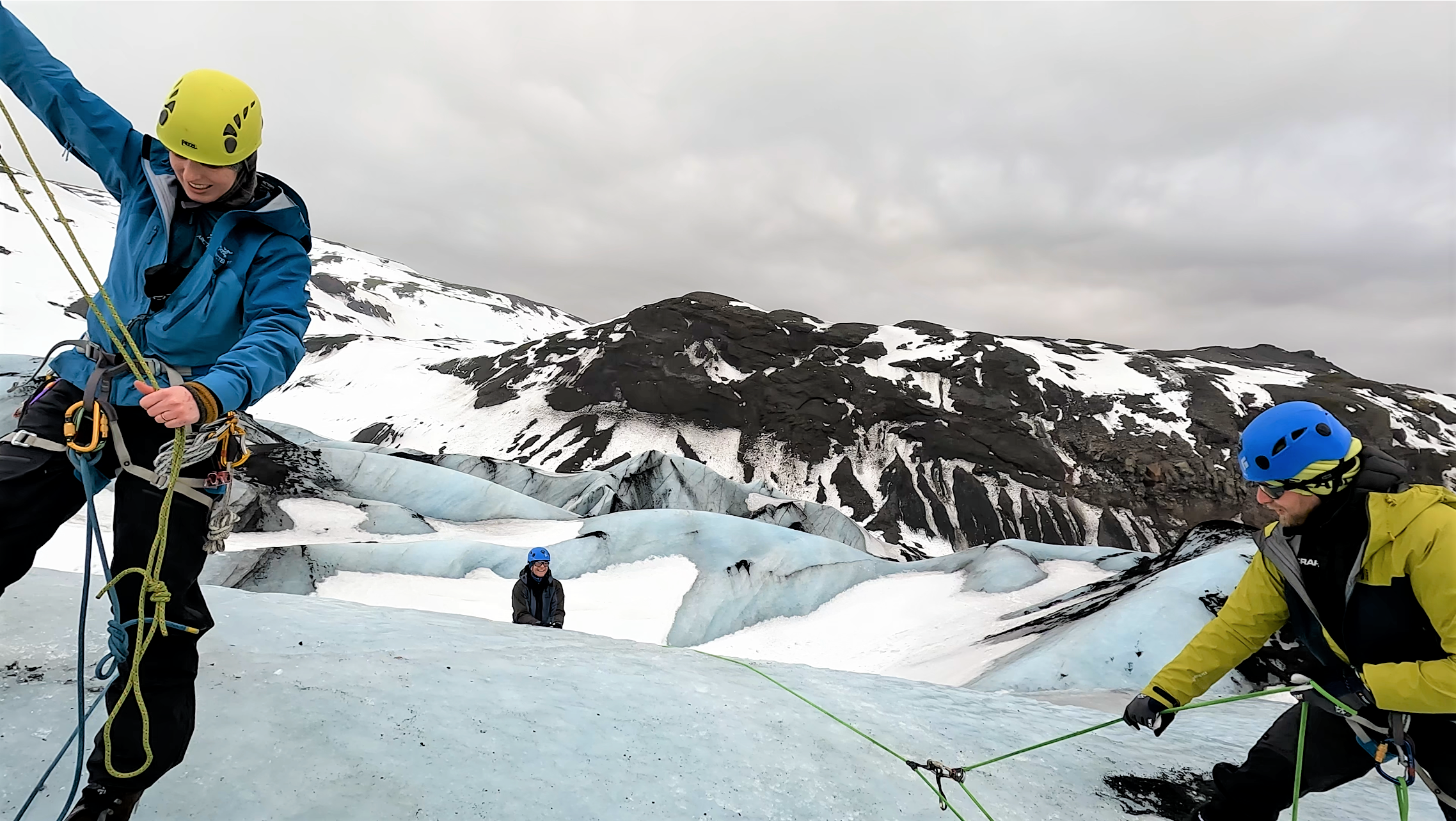
Professor Paul Smeets from Utrecht University being pulled out of the “crevasse” by his Dutch colleague Maurice van Tiggelen while Anja Rutishauser from GEUS unties her pulley system after pulling her colleague up (Photo: Johanne Uhrenholt Kusnitzoff, GEUS)

Practicing ascending the rope in order to rescue yourself from a crevasse or being able to rappell down to a fallen colleague and rescue him/her (Photo: Anne Munck Solgaard, GEUS)
15 metres reaction time
The morning of day two is bathed in sunshine, and everything is beautiful and icy blue. However, it is more windy and colder than the day before. When there is a particularly strong gust of wind, we only stay upright because we’re wearing crampons, sticking us to the ice. We master the hoisting techniques, so now the difficulty level increases.
“Now we practice walking in ‘rope teams’ and what happens when someone from our team falls into a crevasse,” says Mike Reid. If you walk in a rope team in a crevasse-filled glacier terrain, where the crevasses may be covered with snow, you should have a minimum of three people on a team, he says. The distance between each of you should be at least 15 metres of rope, preferably more. Which sounds like and looks like a lot, but of course there is a good reason for this.
“If you walk closer together, maybe with five metres of rope between you, you only have five metres, from your colleague falls into a crevasse, until you are pulled in. It gives you a very short time to react, and you probably don’t have time to react, and then you all die.” Well…
Always travel in teams of three or more people. Then there are always two people to hold the weight from the one that falls and the risk of being pulled down is smaller. If you are only two people, it is very hard to hold the other person and the probability of being pulled down is high (which became clear the following day …).
Not feeling the cold
Thus, the seriousness intensifies, and the weather follows. The sun has disappeared, and the wind has picked up even more. Along with the strong wind comes a good mixture of hail, sleet and rain that whips into the face like needles.
“This is more like it, huh?” exclaims Mike Reid. Which would normally be an annoying remark, but several people on the team cheer and laugh as we in the rope teams of three walk further up the glacier, ever more exposed to the elements.
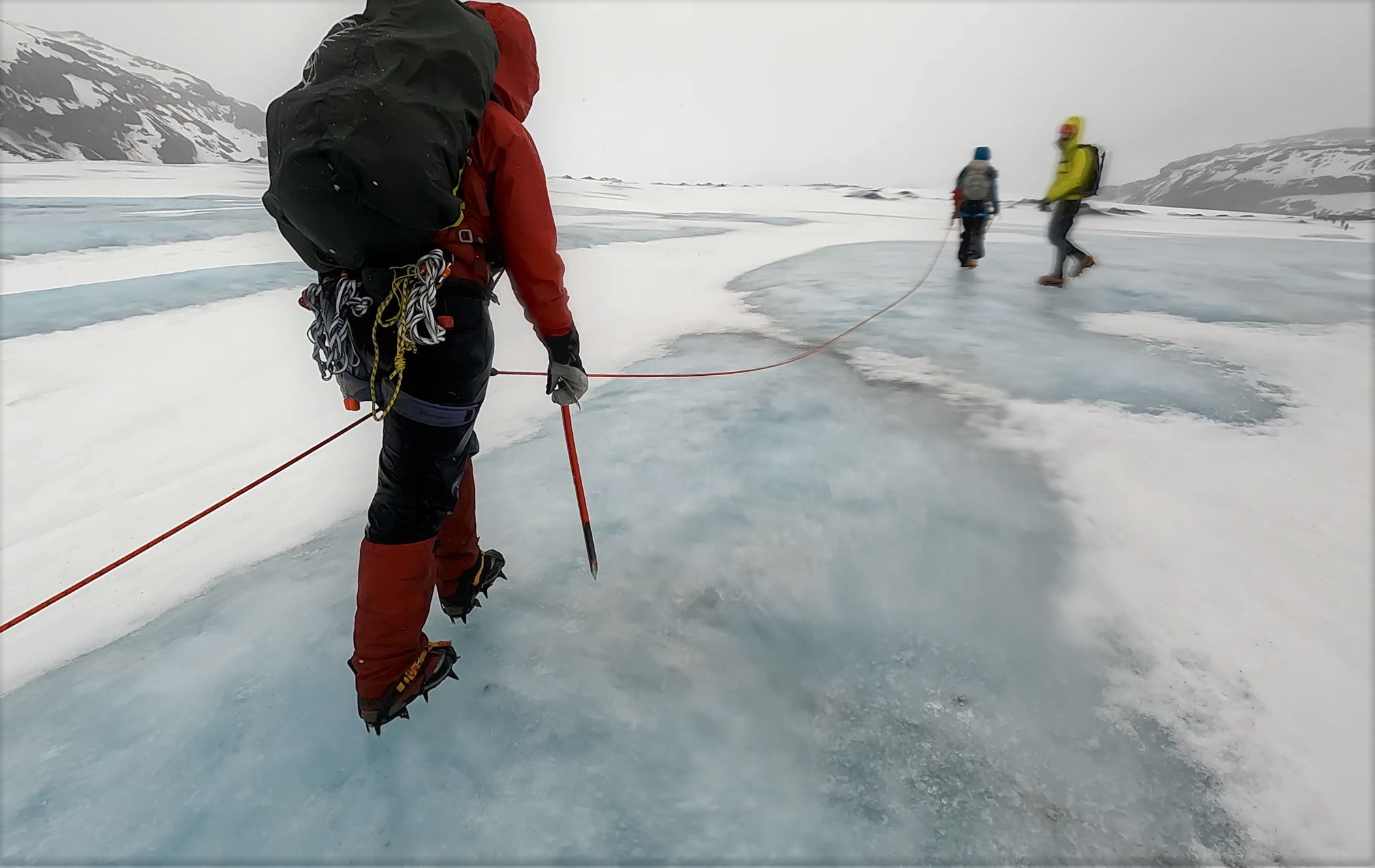
Walking up the glacier to train rescue in rope teams (Photo: Johanne Uhrenholt Kusnitzoff, GEUS)
“This is great!” shouts Anja Rutishauser into the howling wind. The many layers of wool and water/windproofs instil a warm feeling of strength as we stand there on the back of a glacier surrounded by every conceivable form of frozen precipitation but not feeling cold.
In turn, we must now let ourselves fall over an edge, while the two non-fallen rope buddies hold the weight and make ice anchors and pulley systems, respectively. The guides Mike and Jón each take their own sets of rope teams around the entire width of the glacier in search of different kinds of edges and slopes for us to stumble over.
Some have to fall over an icy slope, others down a snowdrift; different scenarios and environments for both fall victim and rescuers. When it’s your turn to be a victim, it’s really nice to just hang out there a bit and make yourself heavy sheltered by your snowdrift while the others work with screws and knots.
When all fall options have been explored and tested and our resistance to cold is declining, we’re done for the day. The hike down the glacier and to the cars takes place in a shared silence.
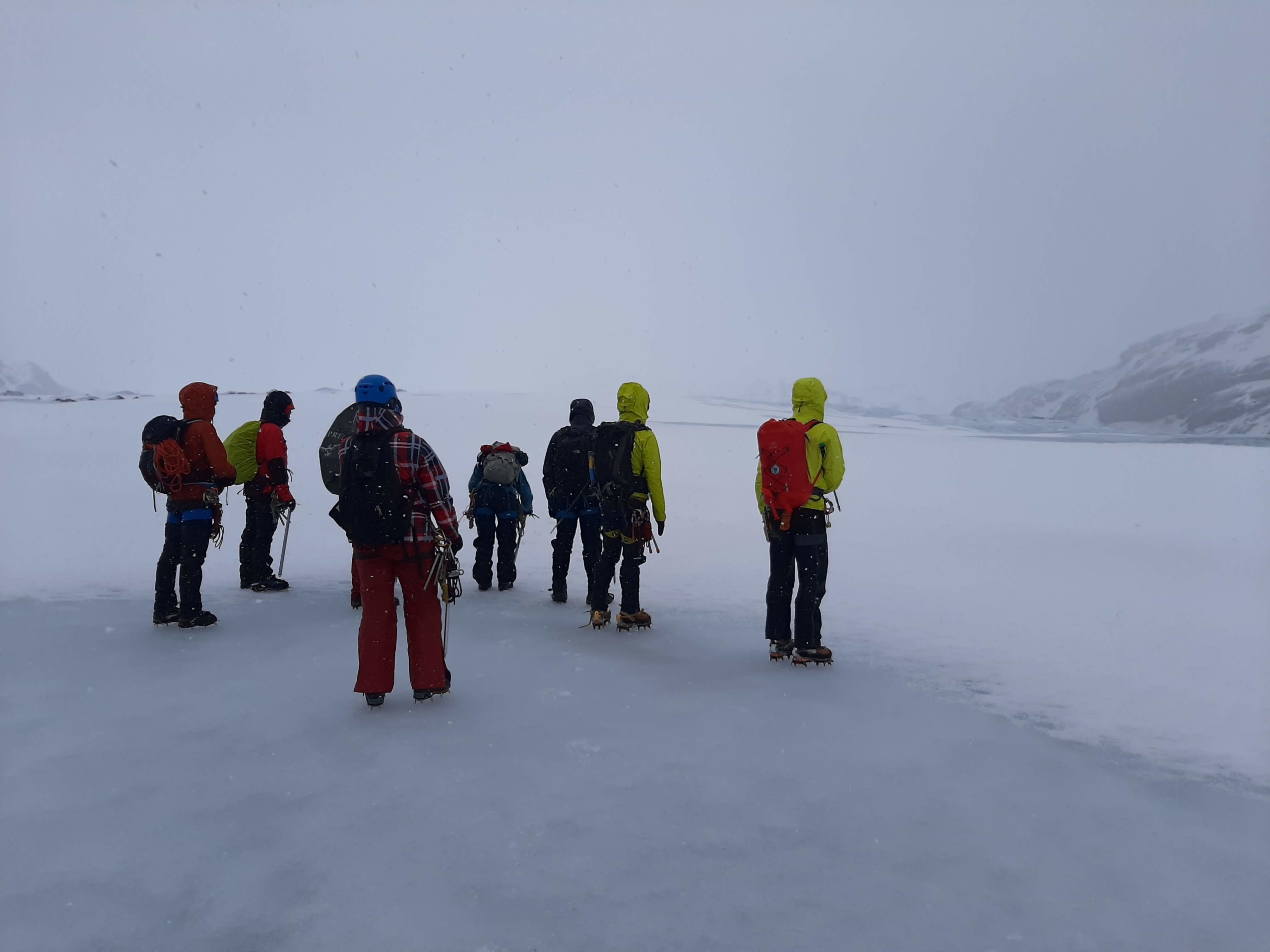
Waiting for a team mate who fell into deep snow and had to be pulled out. When standing still, the least uncomfortable orientation was away from the blazing wind and hail (Photo: Paul Smeets, Utrecht University)
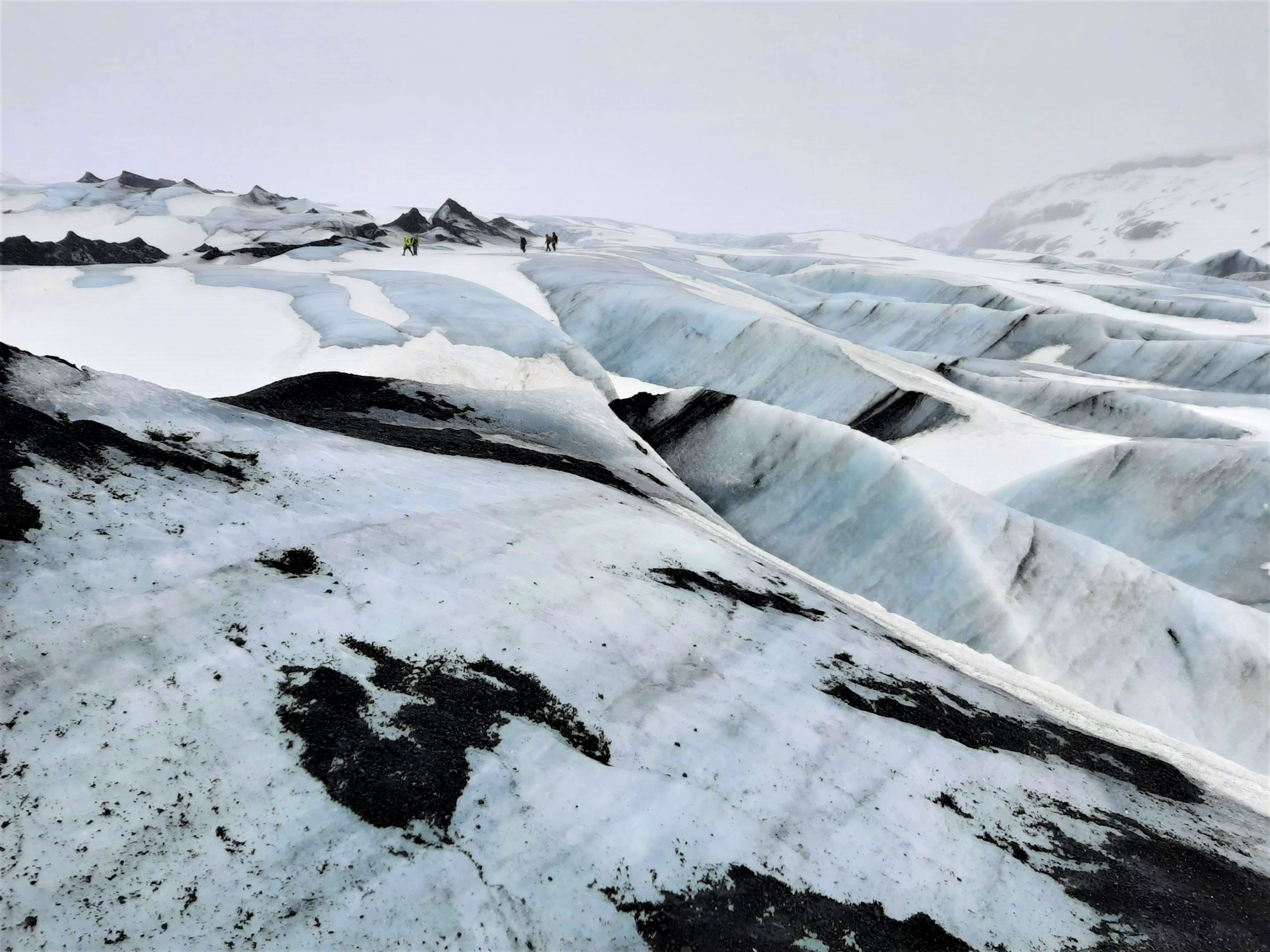
Walking down the glacier towards the warmth of the cars on the second day in bad weather, even though it’s hard to see. (Photo: Paul Smeets, Utrecht University)
A head full of knots
The first and second day of the course proceed with successful, controlled rescue exercises without any big drama, but that changes on the last day of the course. Here, a minimum of six out of twelve participants along the way are declared “dead” by the guides, some up to several times. Either because our rope buddy on the risky two-person rope team did not succeed in stopping the fall before both go over the edge of “the crevasse”, or because the snow anchor failed.
We are no longer at Sólheimajokull, but on a snow-covered slope along a deserted road somewhere half an hour’s drive outside Reykjavik. At the end of day two, it was clear that the whole area around the glacier would be shrouded in a storm that not even the Icelanders would want to be out in. Fortunately, Iceland is full of steep snowy places, so we need not worry about missing out on more falling scenarios. We just moved the events a bit further to the northwest, where the rain and wind were a little less violent.
However, it’s still bad enough for the whole team to be quite knackered in the middle of the afternoon. We have just practiced a version of a rescue where you are supposed to make bypass large knots on the rescue rope illustrating other rope teammates blocking the hauling of the victim. The gloves are soaked, and icy cold, and extra knots seem to have formed on both rope and brain.
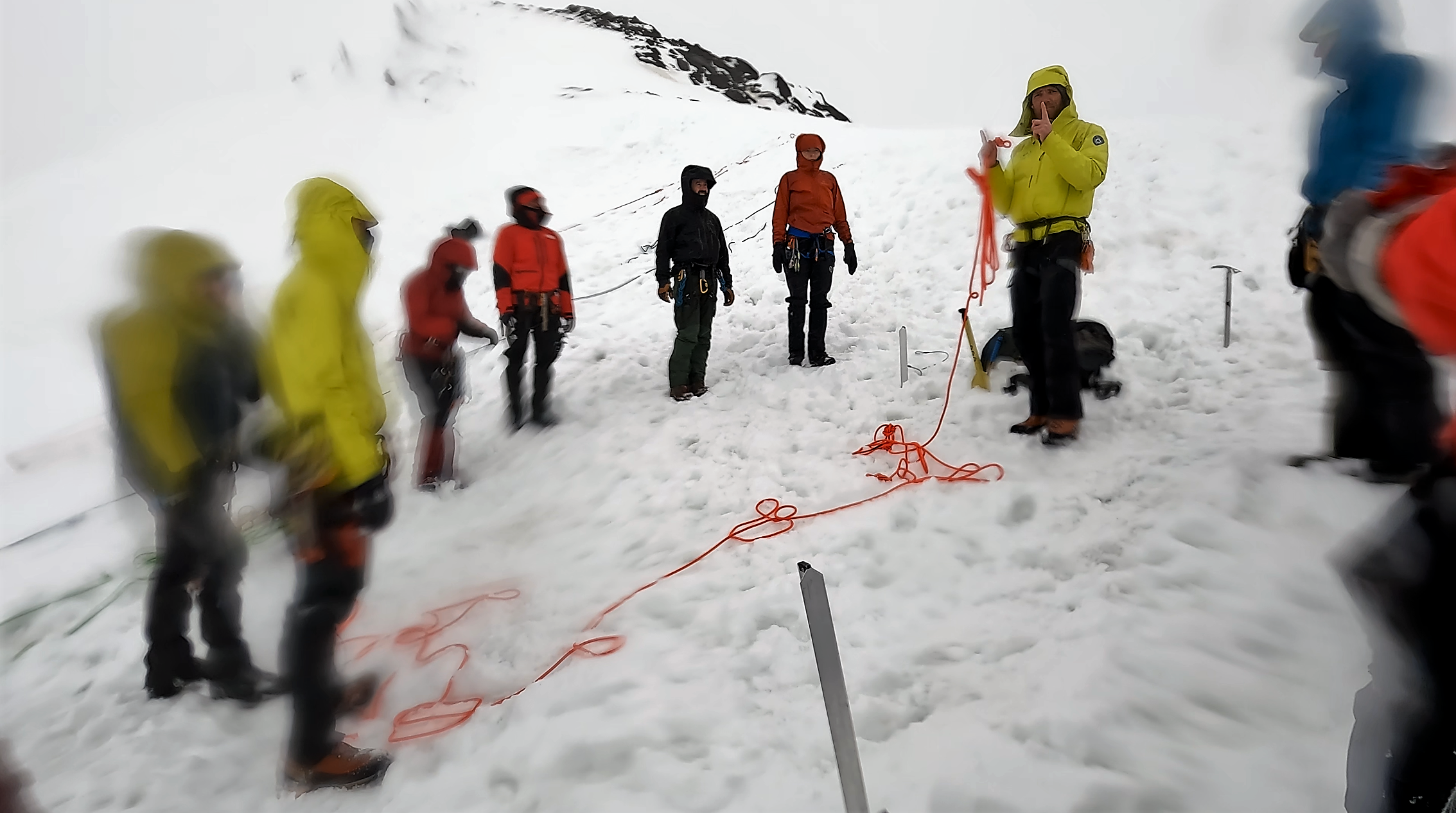
Guide Jón Andressón explaining how to do the knot bypass on the rescue rope. Weather is bad and every one is getting cold (Photo: Johanne Uhrenholt Kusnitzoff, GEUS)
“Jump, face first”
Mike Reid senses the fading spirits on the slope at the end of the exercise and says: “Now you have two options. Do you want to return to the warmth of the cars or do you want to practice ‘self-arrest’ on the hill over there?” We look at him, then at each other.
“Self-arrest,” someone says.
“Great, then come on,” he says, running with impressive speed up the steep, snow-covered cliff.
“Then you just go like this,” he says, as he suddenly lets himself fall freely down the hill. He quickly chops in the ice axe so that snow sprays everywhere, and the fall is ‘arrested’ after maybe ten metres of sliding. This is what we should have done when we were pulled down by our rope buddy …
For a few seconds, several of the researchers stand in the middle of the slope and look hesitantly down towards the bottom. However, everyone has been falling in so many weird ways in the last few days that it doesn’t really seem to matter anymore. One by one, we let our legs slide out and zoom down in a shower of snow and an instant adrenaline rush. It requires some effort to force the ice axe properly into the snow while sliding, so several of the participants slide all the way down the hill some 40-50 metres below.
“Then try and do it face first,” Mike Reid shouts all the way from the top, and does exactly that. Like a bright yellow projectile, he darts down the hill with his arms close to his body, before deploying the ice axe, which then turns him around and stops his fall in the middle of the slope. Not before long, glaciologists are flying down the hill in all sorts of orientations. When people stop themselves, they run up and go again.
For twenty intense minutes, everyone forgets that they were quite cold and wet, snow and ice do not matter. At the end, the sun even breaks through the clouds. Eventually the cold returns and the group walk through the wet snow to the cars. Jón Andrésson gathers the threads before we split up:
“There have been many things going on over the last three days, many techniques, and scenarios. Overall, you have to remember that we have simply trained being able to rescue ourselves and others from a crevasse. So, consider the risks where you are. If there is an accident, keep cool and figure out what makes sense here and now. That’s about it.”
Glacier safety course
Day 1
- Walking on ice with crampons
- Making an ice anchor
- Rappelling up and down a crevasse
Weather: Rain/sleet and wind, periodically nice. Ca. 4oC, windchill ca. – 6.
Dag 2
- Terrain risk assessing, picking the safest route
- Glacier rescue, building a pulley system for hoisting a person/item from a crevasse, different scenarios
- Traveling in three-person rope teams on a glacier, terrain risk assessing
- Glacier rescue in three-person rope teams, different scenarios and rotation
Weather: Sun in the morning, from mid-day strong wind, hail and sleet after lunch. Ca. 2oC, windchill ca. –9
Day 3
- Making a snow anchor
- Glacier rescue in rope teams of two, including stopping a fall on a snow-covered hill
- Glacier rescue in rope teams of several people, bypassing knots on rescue rope
- Stopping a fall with an ice axe/’self-arrest’.
Weather: Heavy wind and rain, change of location necessary. Wind and rain, which die down in the afternoon. Ca. 5oC, windchill ca. – 6.

Day two, during terrain analysis (Photo: Paul Smeets, Utrecht Univertity)
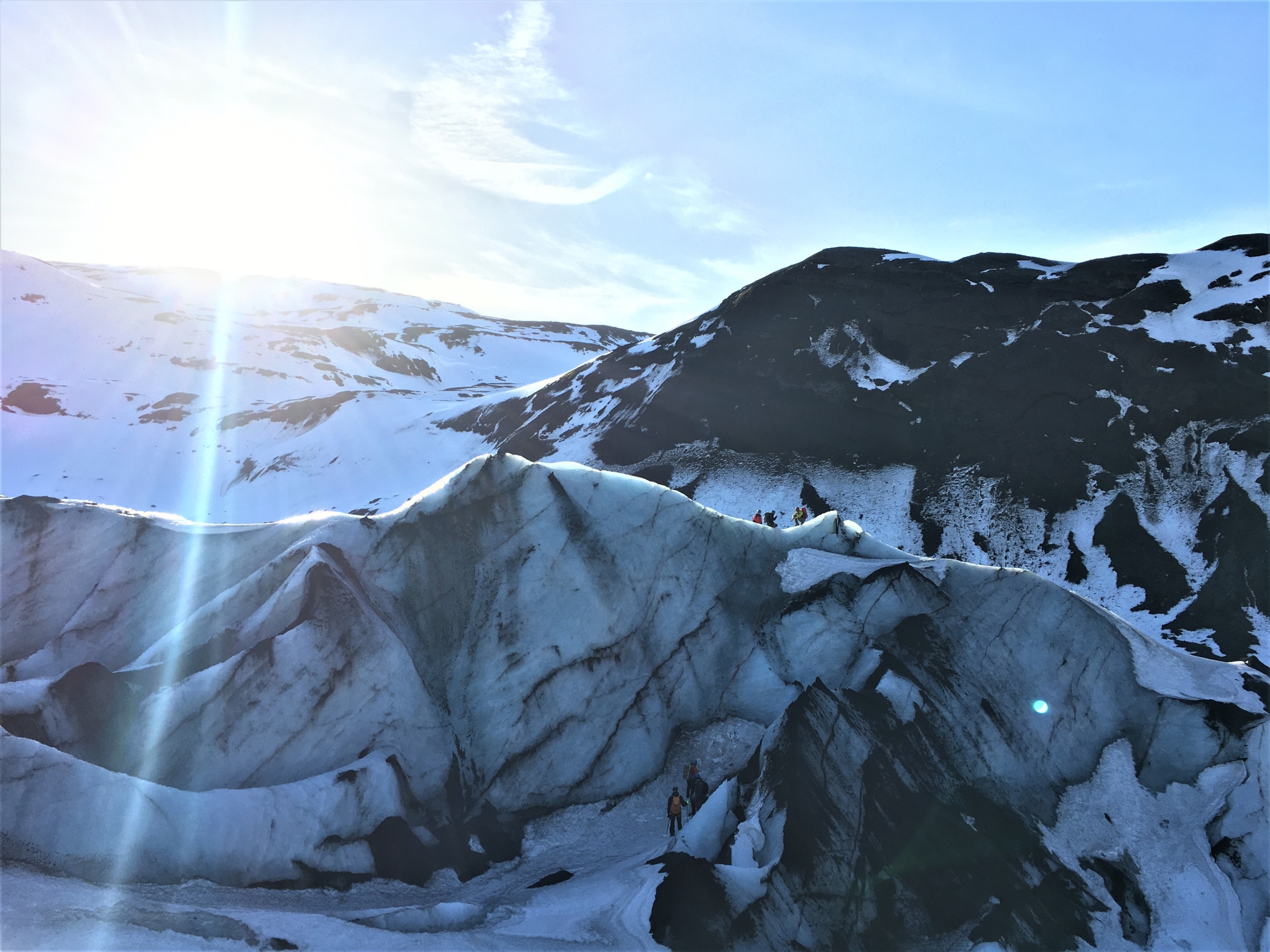
Day two, part of the team choose to rappel down an ice wall while making their way towards the training “crevasse” (Photo: Johanne Uhnreholt Kusnitzoff, GEUS)
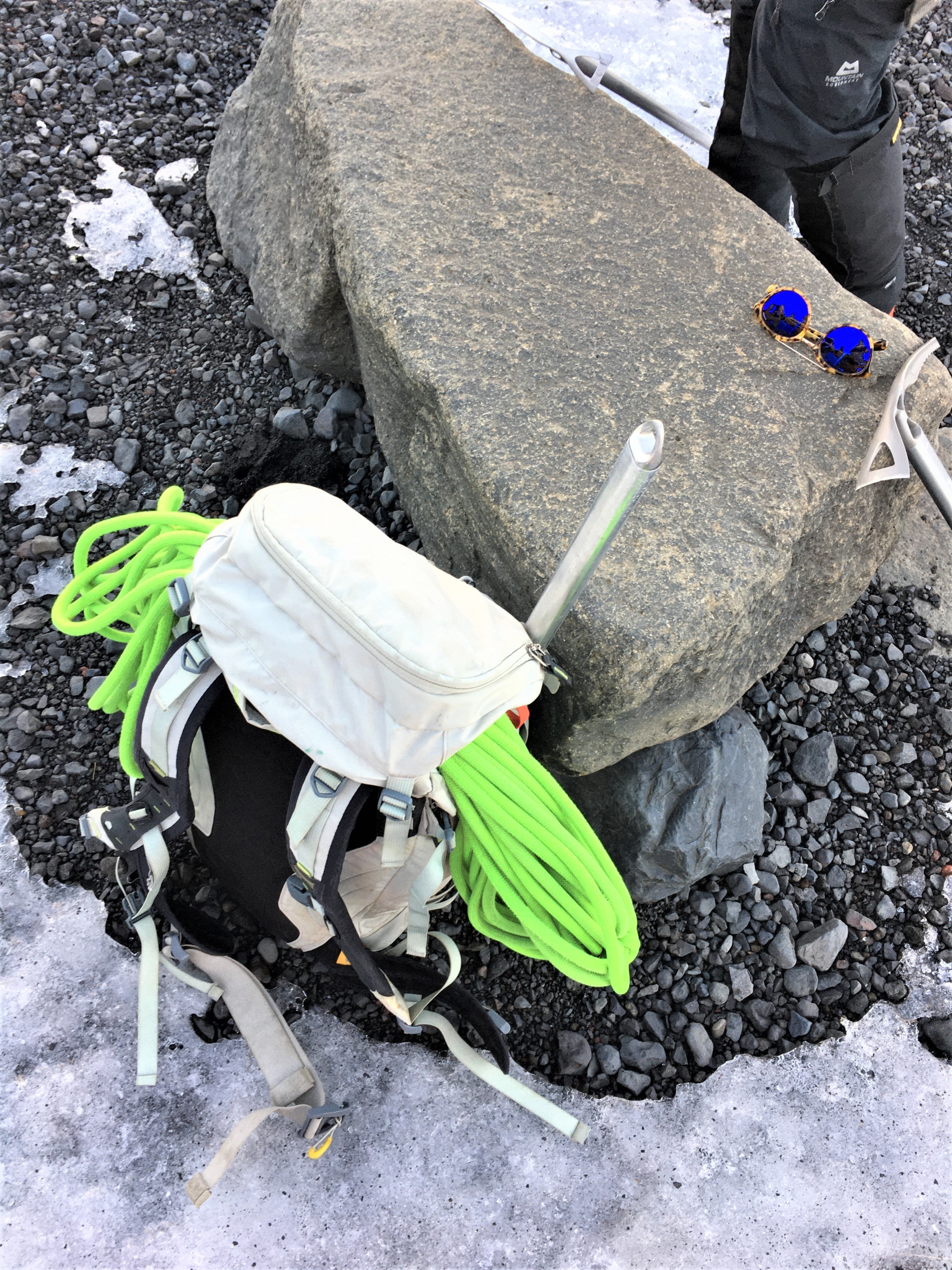

Researcher Signe Hillerup Larsen from GEUS on the ice wall on day one (Photo: Anja Rutishauser, GEUS)
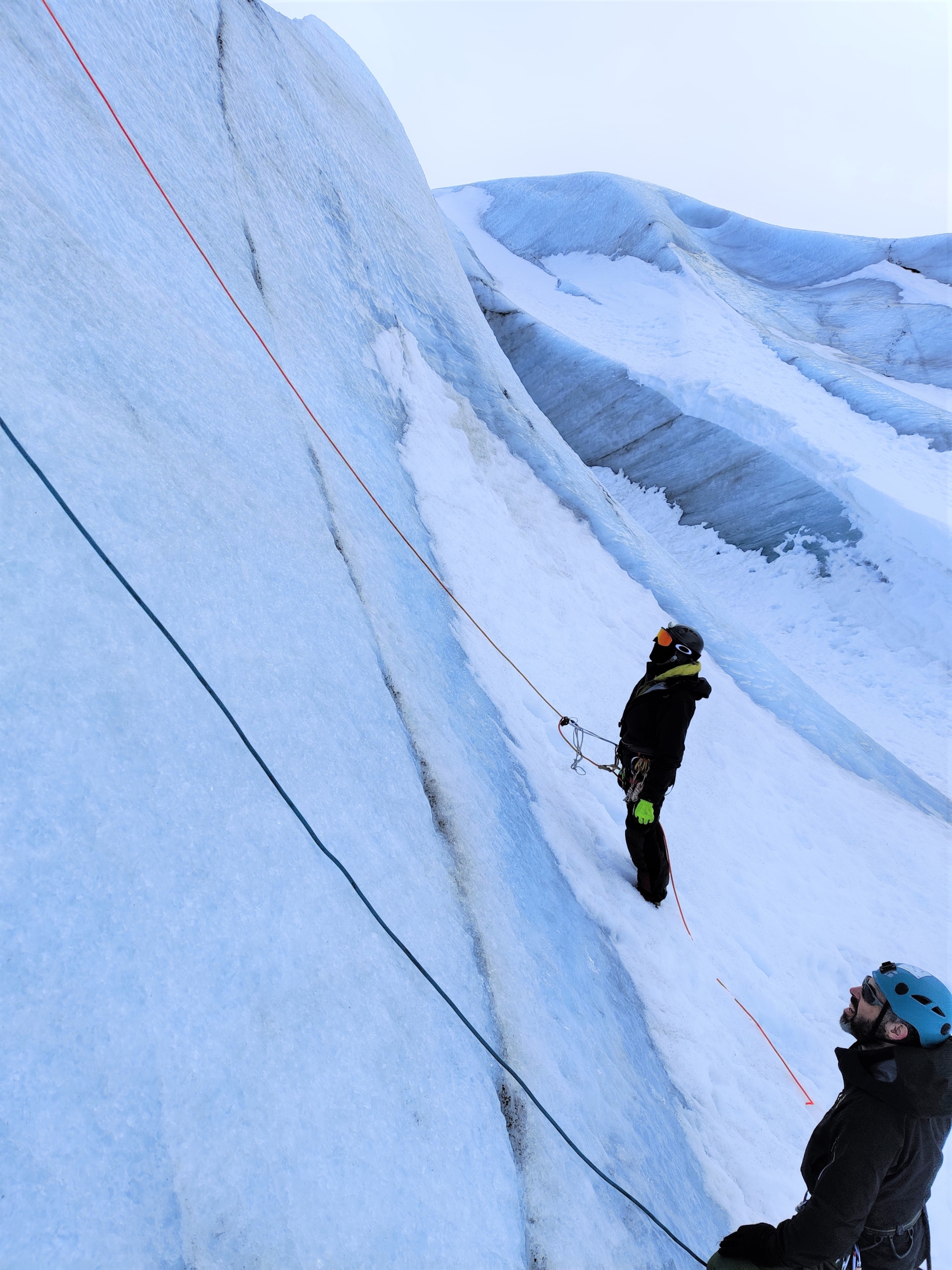
Day two, waiting to be hauled up (Photo: Anne Munck Solgaard, GEUS)
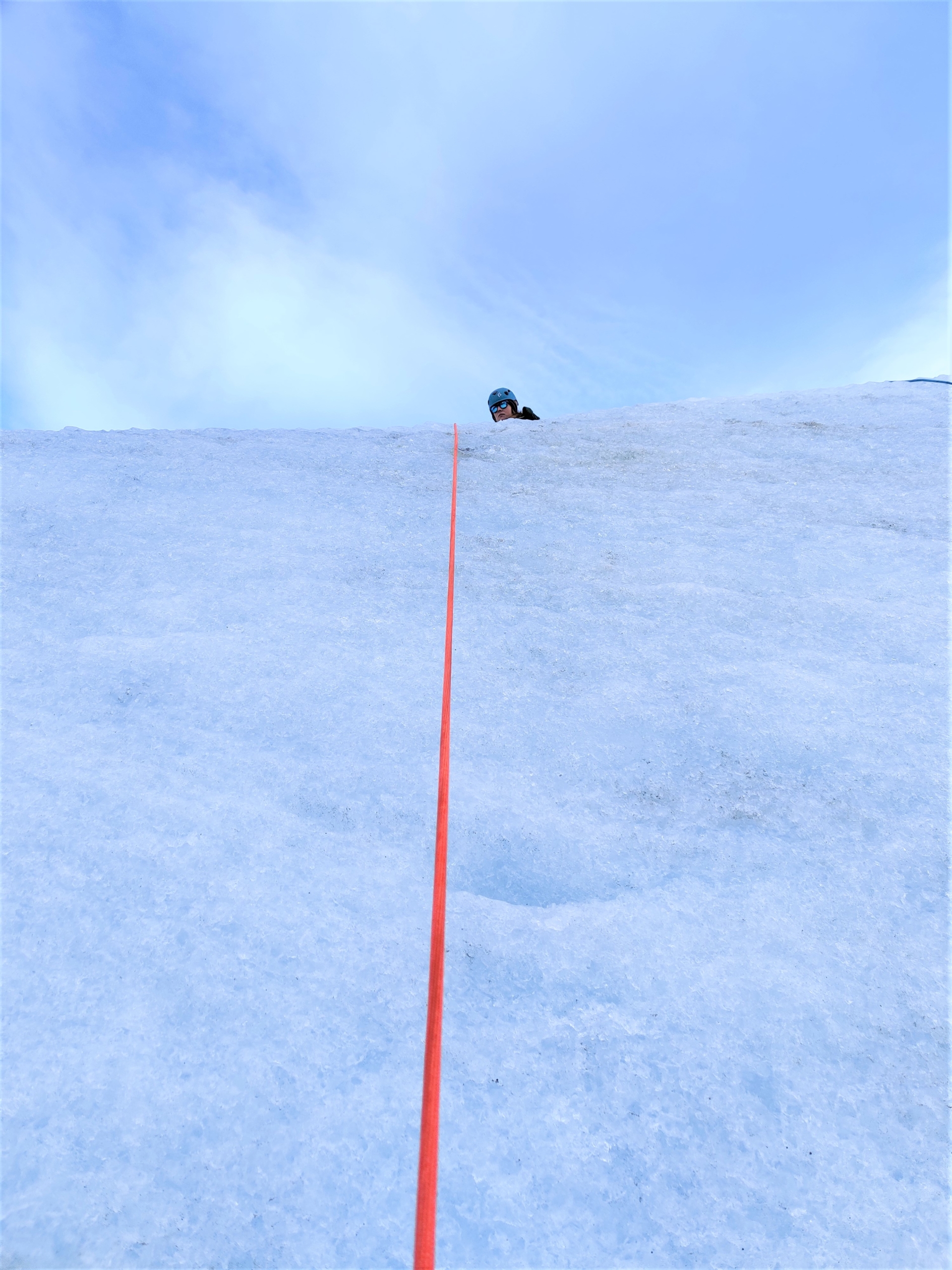
Day two, the one on top doing the hauling. (Photo: Anne Munck Solgaard, GEUS)
